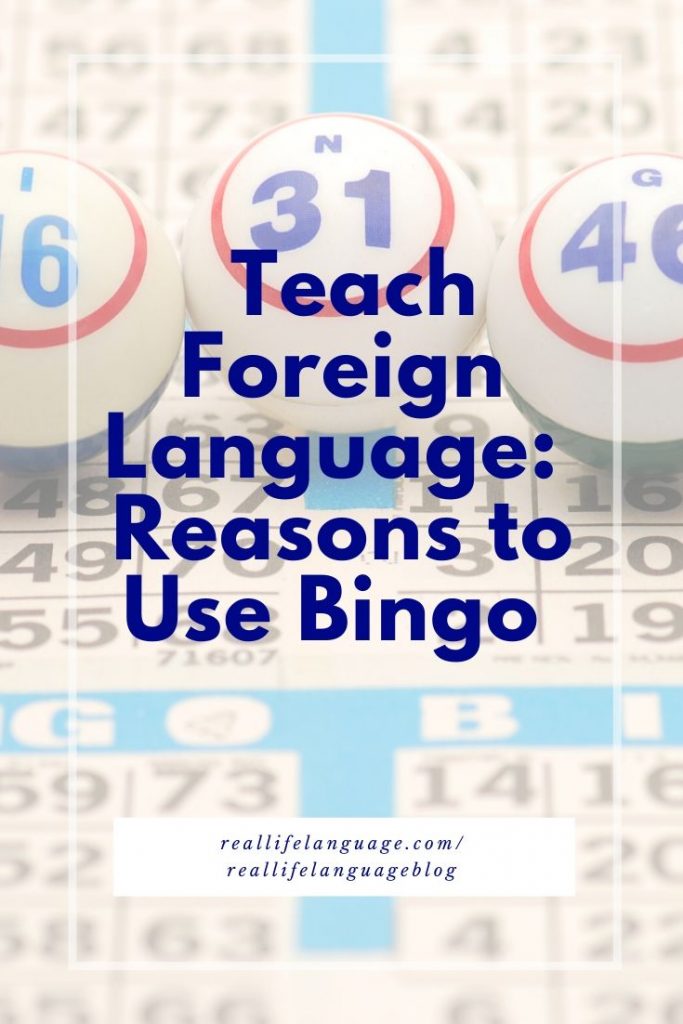
Teach Foreign Languages: Reasons to Use Bingo
Teaching foreign languages can be hard work for students and the teacher. We all know Bingo is a fun way to get in a much-needed change of pace while learning vocabulary at the novice-level. Here are a few reasons to include it regularly in your beginning-level classes.
Instant Total Physical Response.
TPR is a language teacher’s best friend. Total physical response involves the learner having to respond to something in the target language, of course. A lot of computer programs like Rosetta Stone use this method.
At the most basic level, Bingo is total physical response. Students hear and see words and select. They are attentive, they are listening, and they are engaged in the foreign language. You can teach anything using Bingo, and the visuals make it great comprehensible input. You can teach any grammar using Bingo. It is a super useful tool to create effective, engaging lessons.
Get Over the Rough Spots.
Teaching foreign languages can bring a lot of rough spots. I want to share this Bingo card for telling time. If you’ve ever taught beginning foreign language, you will know what a difficult concept this can be. A lot of our students can only tell time digitally, not analog, so they come to your room without that skill, and then you add things like the 24-hour clock, languages that use the equivalent of minus to talk about certain times of the hour in the absence of a.m. and p.m., and it can be extremely difficult.
After a very quick and cursory introduction with a clock where I go through the times, I play this very simple Bingo that I bought for kindergarten-age students. The calling cards have the times in analog. We go very slowly, and I walk around the room showing them the analog card and they have to match the digital card while I say the time in the target language.
We then do some further TPR activities. I have paper plates with movable hands and the students show me the times as I say them in the target language, but this Bingo shaves days off these lessons. We have one very immersive lesson and the students are then ready for the explanation on how to form time. Listening becomes speaking.
Once students become comfortable with this new foreign language class, I usually invite them to work in pairs to be the caller, and I stay near them for support for any pronunciation issues that they might have. These will, of course, be some of the stronger students who volunteer or agree to do this at first, but then you will see students eagerly wanting to be the caller. You will hear them say these words to each other. You will watch language acquisition in progress. Listening will become speaking. So it’s well worth learning, investing in Bingo in your classes.
Some concepts that I’ve taught through Bingo that were difficult and Bingo, shaved days off them: the alphabet in foreign languages, time, verb tenses, adjectives, just to name a few. Bingo can become interactive and communicative.
Have students can play in teams. This works well if you have a more difficult concept or you have a group that needs support. Everyone feels secure that if they didn’t understand, their partner will. They can also discuss the answers. Intuitively, that might not seem great, but a lot of learning takes place. This can really help them learn some more difficult grammatical concepts.
Some more ways to teach foreign languages and get over the rough spots:
http://reallifelanguage.com/reallifelanguageblog/2019/11/04/teaching-a-foreign-language/
Bingo is Communicative and Interactive.
You can add grammar into your basic vocab. This works great with smaller groups. For example, you might say in your target language, “Do you have the book?” “Yes, I have the book,” the student might say, or they might write a note on a piece of paper.
You can also make human bingo, which is very interactive. You basically take a grid and everyone has to go around and find information. It’s sort of Find Someone Who, but it can also be used like bingo where you take those results, you write them on the sheet of paper, students will go around and speak to each other, and the first one to get the pattern of your choosing, one line, two lines, X, four corners, will get Bingo.
I like to make this progressive where the first winner maybe gets one line, the second winner gets an X, the third winner gets, forms a star with the questions that they’ve answered, so it’s continually played until you get blackout. Super fun. Interactive. Kids are walking around and they’ve got speaking prompts right on their paper.
Teach Any Set of Vocabulary.
Bingo works for any theme and can easily be adapted to supplement any curriculum or textbook.
Turn Downtime into Language Learning Time.
It’s great to pull out Bingo when you’ve got a few extra minutes in class. It keeps everyone engaged and learning. I love to give fun prizes like pencils and erasers and bookmarks with my target language on them.
It’s Fun!
Bingo is fun. You won’t feel like you’re lecturing. Students won’t feel like you’re lecturing, and everyone will be learning and having a good time at the same time.
Looking for some ready-made bingo to teach foreign languages in your class? Check out my games here:
https://www.teacherspayteachers.com/My-Products/Category:223296